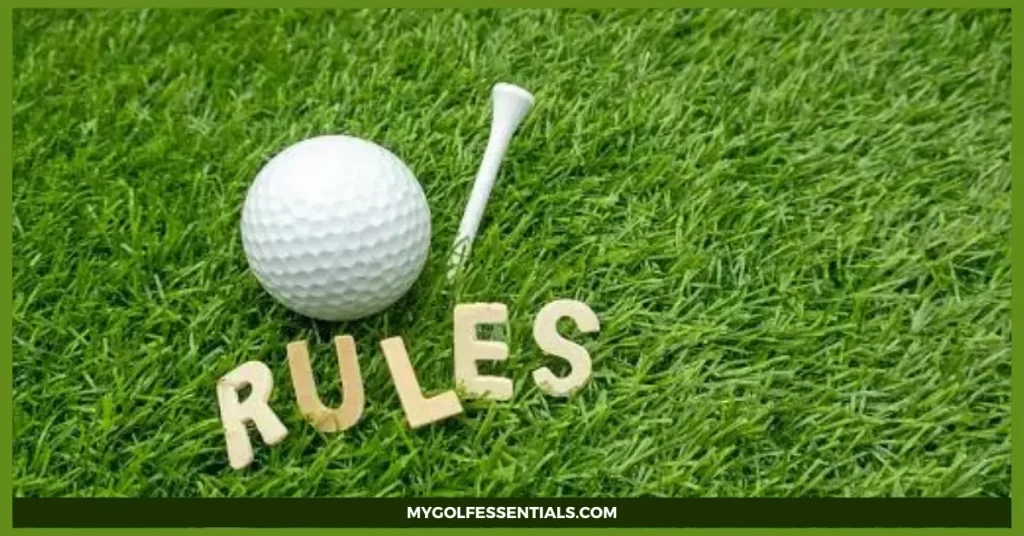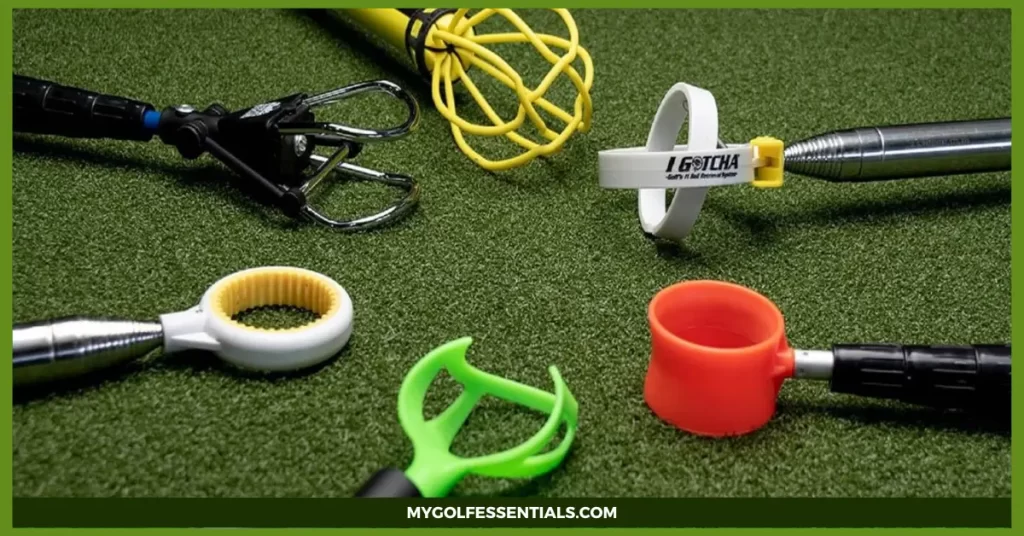
If you’re getting into golf, one of the first things you must understand is the rules. Knowing them will not only help you avoid penalties and embarrassing moments on the course, but more importantly, it will ensure everyone has an enjoyable experience while playing a game they love!
From basics like the difference between a practice swing and a stroke to understanding out-of-bounds aggravations, getting familiar with these rules can help all levels enjoy their round of golf without unintended stress and uncertainty.
Overview of the basic rules of golf

Golf is a sport that dates back centuries and has been enjoyed by millions of people around the world. It’s also renowned for its strict rules, which can often seem complex and intimidating to those new to the game. Here we provide an overview of some basic golf rules to enjoy this wonderful game without worry.
First and foremost, it’s important to know that the ball should be played from where it lies. You can’t move the ball or improve its lie within a hazard (such as a bunker) without penalty. Nor can you replace a damaged golf ball with another one. You’ll be penalized with a stroke or stroke if you do things like this.
The golfer should also hit the ball only with their clubs and not touch other objects during the swing, such as trees, twigs, leaves, etc. Doing so will result in a penalty. The rules also dictate that the golfer should take no more than 40 seconds to hit the ball when it’s their turn. This is known as “pace of play,” designed to keep the game from dragging on too long.
7 Main Rules of Golf for Beginners

Golf is a complex yet enjoyable sport with lots of rules and regulations that must be followed. If you are starting, it’s important to understand the basic rules of golf to enjoy your game experience without unwanted disruptions or confusion. Here is a quick summary of the seven main rules for beginners:
1: 14-Club Rule
The 14-club Rule is a fundamental rule that states no golfer should carry more than 14 clubs during a game. This helps to level the playing field and ensure fairness as it restricts how much advantage a player can gain from selecting specialized clubs for different situations.
2: Play Behind the Tee Markers
When teeing off, it is essential to follow the tee marker guidelines. When hitting your first shot, you must line up behind the tee markers and not in front of them. This ensures you do not gain any unfair advantage, as all players should start from the same place.
3: Play the Ball as it Lies
Another important rule is to play the ball as it lies. This means you cannot move, bend, or interfere with any course part other than to line up your shot. If your ball lands in an undesirable spot, such as a puddle or sand trap, you must take it from there and focus on making the best shot possible.
4: Out of Bounds
The out-of-bounds Rule is straightforward – any shot that lands outside the designated playing field, such as a body of water or road, counts as an automatic stroke penalty. Pay attention to the course layout before teeing off to avoid straying off track.
5: Understanding Hazards
Hazards refer to any part of the course that can interfere with your shot, such as sand traps or water hazards. When a ball lands in a hazard, it must be played as it lies and cannot be moved or touched. You must take an additional penalty stroke if you cannot strike the ball from its current position.
6: Unplayable Lies
If a golfer’s ball lands in an unplayable spot, such as a bush or tree branch, they can take the penalty stroke and then take their next shot from the original spot or up to two club lengths away. The golfer must determine which is the best option for them.
7: Cart Path Relief
If your ball lands in an area blocked by the cart path, you can take relief from the nearest point of complete relief. This means you will move the ball away up to one club length (no nearer to the hole) and then hit your shot without penalty.

What are the rules for proper dress on a golf course?
On the golf course, proper dress is required for all players. This includes shirts with collars and sleeves, slacks or short ts that are not excessively baggy or frayed, and closed-toe shoes. Denim of any kind is usually prohibited. Most courses also require hats to be worn facing forward. It is best to check with the golf course in advance to ensure you know their dress code.
Additionally, soft spikes or spikeless shoes must be worn on most courses to protect the greens. Golfers should also remember that remaining quiet and respectful while playing on the course is important to avoid disturbing other players.
Finally, following all other golf course rules is important, including not picking up leaves or debris on the greens and adhering to proper etiquette. Following these guidelines will help ensure your time on the golf course is enjoyable for everyone involved.
How to properly prepare yourself before playing a round of golf

Before heading out to the golf course, preparing yourself physically and mentally is important. Doing so will help you enjoy your round of golf while also playing to the best of your ability. Here are some tips on how to get ready:
Stretch & Warm Up: Before each game, it’s important to warm up your muscles, joints, and tendons. Doing so can help you hit the ball farther and more precisely since it reduces the chance of injury and makes your muscles flexible. You can also practice swings with a golf club before teeing off for added preparation.
Review Golf Rules: Before starting your round, review the rules of golf so that you are up to date and can play with etiquette. This will help you avoid any misunderstandings or embarrassment on the course.
Bring Essentials: Make sure to bring the essential items for a successful round, such as golf clubs, tees, balls, gloves, and an extra layer of clothing in case it is cold. Other accessories like sun protection, a hat, or sunglasses can also be useful.
By following these steps, you can properly prepare yourself to make the most out of your round of golf! Have fun and enjoy the game!
Rules and regulations for completing a hole in the least number of strokes

Golf is a game of precision and skill. Players must adhere to certain rules to play the game fairly and competitively. The primary Rule for completing a hole in the least number of strokes revolves around keeping track of each shot taken and playing from where your ball lies.
Players must tee off on each hole, except when the hole is a par-3, in which case players can opt to putt. The ball must be placed within two club lengths of the tee box and may not move until after contact with the club. If a player’s ball lands in a hazard, such as water or sand, they are allowed one free drop from that hazard with no penalty.
When the ball is in play, players are not allowed to move, touch, or hold down any natural or artificial object that may alter their shot in any way. In addition, players may not improve their lie by moving loose impediments on the course. If a player moves his ball accidentally (not intentionally), they must replace it with no penalty.
Players cannot touch the flagstick while the provisional ball is in motion. If a player’s ball rests on or near the putting green, they must move the flagstick away before attempting their shot. When the ball is on the green, players may mark and lift their balls to clean them, but they must replace the ball in its original spot.
Understanding when to take relief from hazards or other obstructions
Golf rules allow players to take relief from certain obstructions such as water, sand traps, and other hazards. Relief can be taken in two ways: through a drop or by taking the ball away and playing it from another area no closer to the hole.
When taking relief from an obstruction, you must first identify the type of obstruction and the type of relief available. If unsure, reference a rules book or ask an official on the course.
When taking a drop, you must stand up to two club lengths from the point where your ball came to rest, no closer to the hole. It would be best to drop your ball within this two-club-length zone. If the ball comes to rest in a penalty area, you must drop it another two club lengths away from the obstacle and no closer to the hole.
Finally, you must commit to a particular relief method before any strokes are played when taking relief from an obstruction. Once your decision is made, it cannot be changed.
Remember, following the rules of golf is essential to an enjoyable and fair game for everyone. Ensure you understand when it is appropriate to take relief from obstructions before beginning your round!
Tips for improving your game by following proper etiquette and courtesy on the course
Golf is a sport that requires both physical and mental skills. It also requires players to follow the rules of etiquette and courtesy when on the course. Following proper golf etiquette ensures everyone enjoys their time and can help you improve your game. Here are some tips to ensure you get the most out of your next round of golf.
1. Respect the Course- It is important to respect the course and practice good care for the grounds. This means repairing divots, filling holes, and not walking on closely-mown areas. When playing a bunker shot, take care to rake it nicely afterward and try not to make any unnecessary marks with your club when playing a shot.
2. Dress Appropriately- Golf courses usually have a dress code that players should adhere to. This is not only for courtesy and respect but also to keep the golf course neat and preserve its condition for future play.
3. Play at a Reasonable Pace- Try not to slow down other players, as this can distract and disrupt the game’s enjoyment. Respect others on the course by keeping up with the group before you or allowing groups behind to play through if they are play-ready golf.
4. Follow Golf Rules- Following golf rules is necessary for all players to ensure everyone plays fair and has an enjoyable experience. Know the local rules and regulations to properly adhere to them.
By following proper etiquette and courtesy on the golf course, you will have a better time, and others around you will also. Following these tips will help create an enjoyable environment, improving scores in the long run.
Remember, golf etiquette is about more than just avoiding embarrassment; it reflects respect for the game and its players. So please do your part to ensure everyone enjoys their round of golf!
FAQs
How Do Golf Rules Work?
The rules of golf are determined by the Royal and Ancient Golf Club of St Andrews (R&A) in consultation with other organizations, such as the United States Golf Association.
The rules govern everything from how the game is played to what equipment can be used. All golfers must understand and abide by these rules to enjoy a fair game. The R&A publishes an annual Rules of Golf book, the authoritative source on golf rules.
What are some common golf penalties?
Common penalty strokes can be assessed for violations such as playing the wrong golf ball, hitting an incorrect tee shot, or making too many one-stroke penalty on a hole.
It’s important to understand and follow the rules so that you don’t incur any penalty strokes. Other penalties are out-of-bounds (two-stroke penalty), lost ball (1-stroke penalty), and water hazard (1-stroke penalty).
What is the difference between a stroke and a match play event?
Stroke play events are scored by counting the number of strokes taken on each hole, with the lowest overall score declared the winner. Match-play events involve two players or teams competing against each other.
The goal is to win a hole by taking fewer strokes than your opponent. The winner of the match is the player or team who wins more holes than their opponent, or if all 18 holes are played, the player with the lower score overall.
How Does Handicapping Work In Golf?
Handicaps are used to measure a golfer’s potential playing ability. Each player is assigned a handicap based on their average scores over several rounds of golf.
The handicap system allows different players to compete against each other using a common measure.
Conclusion
I hope this guide has helped you understand the rules and regulations of golf. Playing by the rules is essential for any competitive or recreational golf game, whether on a professional course or in your backyard.
Following these rules can help ensure everyone has an enjoyable experience and keeps the integrity of the sport intact. With the article given, it’s time for golf to put your knowledge into practice and get out on the course! Have fun and enjoy the game of golf.



